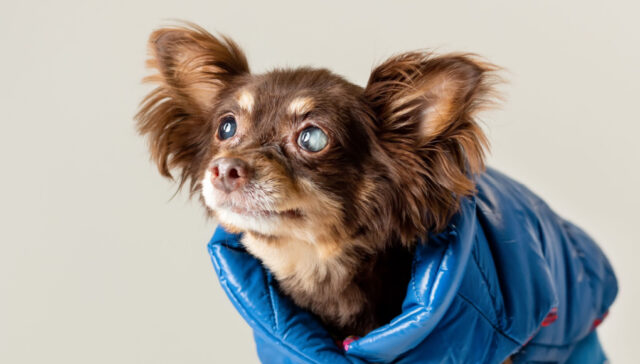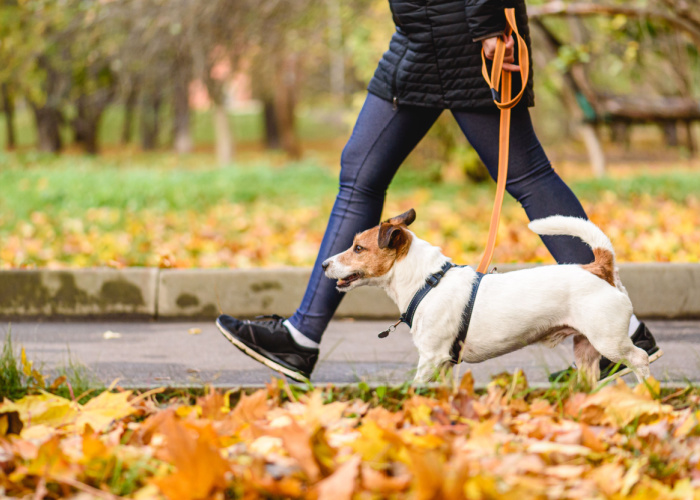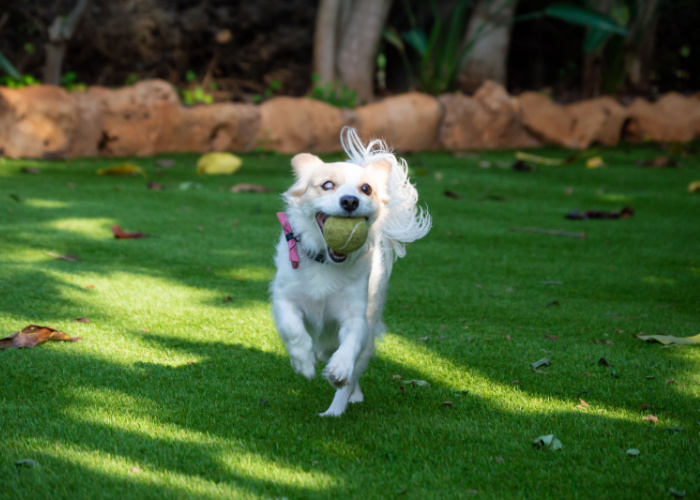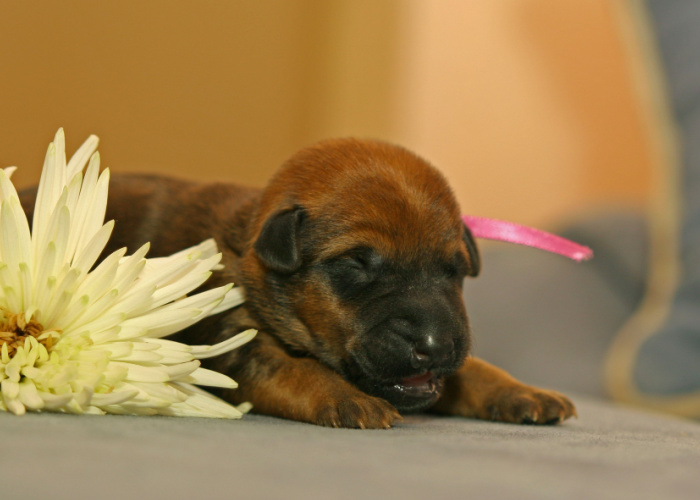
Table of Contents
- 7 Vital Training Cues on How to Walk a Blind Dog
- How to Walk a Blind Dog: 9 Best Tips to Keep Your Blind Pup Happy
- 1. Go for early-morning or late-night walks
- 2. Teach your blind dogs simple word commands
- 3. Take small steps
- 4. Slowly take your dogs for a walk during busier times
- 5. Guide them back to their safe zone
- 6. Give positive reinforcement
- 7. Don’t change an important routine or stuff at home
- 8. Pet-proof your home
- 9. Supervise your children around your blind pups
- How to Walk a Blind Dog: 9 Accessories and Toys You’ll Need
- How to Walk a Blind Dog: Before You Go…
Living with a blind dog means you are their eyes.
I know this is a tough journey for fur parents when their beloved pups go blind.
But it’s important to know that this circumstance shouldn’t stop you and your blind dog from living normal, happy lives together.
At Top Dog Tips, we’re rooting for you!
So in this blog, I compiled all the essential things you need to get acquainted with, such as:
- 7 Training cues on how to walk a blind dog
- Best and practical tips to keep your blind dog happy
- Important accessories and toys for your blind dogs to try
Before you proceed, I want you to know that your dog is still a badass when it comes to its sensory abilities.
A study finds that dogs have a “flexible use of different sensory modalities.”
Experts also suggest that, especially in the absence of light:
…dogs spent a longer time actively searching and sniffed more.
While this experiment didn’t specifically include blind dogs, you’ll get the idea that visually impaired pups can still thrive even in physical constraints like losing vision.
So, cheer up hooman, and let the learning begin!

7 Vital Training Cues on How to Walk a Blind Dog
There’s no magic potion that can help you speed up the process.
And neither will I recommend immediately walking your blind pup on the streets without proper training.
Important: Teach your blind dogs some safety cues first.
1. Name + “Watch” Cue
The most important thing that your blind dog must learn before anything else is its name.
Purpose: Allows your blind dog to avoid upcoming obstacles and pay attention to the next cue you’ll give.
Goal: Your dog must turn toward you rather than walking forward.
Materials Needed: Leash with a harness, clicker, treats
Pre-instruction: Adjust the leash and make sure your dog is at a close distance from you.
Follow these steps to help you achieve the goal:
Step 1: Say your blind dog’s name. When it turns toward you, click and give the treat. Do this 5 times, then end the session.
Step 2: If your blind dog doesn’t turn toward you, gently guide it toward you with the leash.
Step 3: Some blind dogs can be stubborn. So, lure it with a treat towards you. Click and treat when it’s facing you. Do this 5 times.
Step 4: Slowly eliminate the treat lure as soon as you can. Focus on calling its name and click-treat.
Step 5: Once your blind dog pays attention to its name, do this session in various locations.
Step 6: After your dog pays attention to its name, start teaching it the “watch” cue.
Step 7: Say “watch,” and when it turns toward you, click and treat.
Step 8: If it doesn’t automatically turn toward you, guide your blind dog gently using the leash or a treat lure as described in steps 2 to 5.
Inspiring Read: Blind Border Collie Can Play Fetch
2. “Walk” Cue
Purpose: Allows your blind dog to know when it’s OK to move ahead.
Goal: Your blind dog needs to understand that “walk” means moving forward.
Materials Needed: Leash with a harness, clicker, treats
Follow these steps to help you achieve the goal:
Step 1: Say the cue “walk” when you start moving. Click and treat when your blind dog moves forward.
Step 2: If your dog doesn’t, you can lure it with a treat. After your dog moves, click and treat.
Step 3: Practice in various locations and with longer walks after your blind dog understands the cue.
Tip: Take 2 steps, then 4, then 10, and so on. Or you can shuffle the number of steps, too (4, 2, 10, etc).
Inspiring Read: Blind Therapy Dog “Smiley” Takes Blind Rescue Pup Under His Wing
3. “Stop” Cue
Purpose: Allows your blind dog to know when to stop moving.
Goal: Your blind dog needs to understand that “stop” means not making any movements.
Materials Needed: Leash with a harness, clicker, treats
Follow these steps to help you achieve the goal:
Step 1: Say the cue “walk” and move 4 steps forward.
Step 2: When your blind dog is moving with you, say the cue “stop” and freeze.
Step 3: Use gentle leash pressure or your hand on your dog’s chest to stop it from moving forward.
Step 4: When your blind dog stops moving forward, click and treat.
Step 5: Repeat this pattern 5 times.
Tip: Go for a varying number of steps moving forward. Your blind dog must understand that “stop” means staying still regardless of the number of steps taken.
Step 6: Command your blind dog to move forward again when you say the cue “walk.”
Inspiring Read: Blind Golden Retriever Lands Unbelievable Job

4. “Step Up” and “Step Down” Cue
Purpose: These cues are great for taking the stairs, curbs, or an elevated training platform.
Goal: Your blind dog needs to understand that these cues signal up and down directions.
Materials Needed: Leash with a harness, clicker, treats
Follow these steps to help you achieve the goal:
Step 1: Guiding your dog, take 1 step up. Click and treat when your blind dog steps up.
Step 2: Slowly take and guide your dog to take 1 step down. Click-treat when it moves down.
Step 3: Click-treat and see if your dog goes up or down on its own.
Step 4: After your dog comfortably takes steps up and down, add the cue “step up” or “step down” along with the corresponding movement.
Step 5: When your dog follows these cues effectively, go ahead and practice at different platforms like stairs and curbs in various locations.
Related: Blind Dog Treatment: Can We Still Save Their Eyes?
5. “Left” and “Right” Cue
Purpose: Allows your blind dog to easily navigate its surroundings.
Goal: Your blind dog needs to understand when to turn in a different direction.
Materials Needed: Leash with a harness, clicker, treats
Follow these steps to help you achieve the goal:
Step 1: Guide your blind pup to your right.
Step 2: Click-treat when your dog follows the direction. Repeat 5 times.
Step 3: Add the cue “right” as you guide your pup. Repeat 5 times.
Step 4: Try to eliminate the treat after your dog understands the cue.
Step 5: Repeat the same process to teach your pup to turn left.
Related: How To Care For A Blind Dog
6. “Come” Cue
Purpose: General safety of your blind dog, whether outdoors or indoors.
Materials Needed: Leash with a harness (when outdoors), clicker, treats
Follow these steps to help your dog understand the “come” cue:
Step 1: Hold a treat in front of your dog’s nose.
Step 2: Say your dog’s name and “come, come come!” Take a step back as you say it.
Tip: Produce a high-pitched, happy voice when saying this cue.
Step 3: Be generous when your blind dog reaches you. Click-treat-treat-treat. Give 3 treats after the click. Do this exercise 5 times.
Note: Most professional trainers discourage repeating commands.
But since blind dogs rely heavily on their sense of hearing, you can repeat the cue “come” 3 times.
Be sure to make it sound like a single word.
Step 4: As you continue, back away more steps. Go 10, 15 steps, and so on. Click and treat-treat-treat when your blind dog reaches you.
Step 5: Once your dog gets the pattern, click and treat when he comes to you. You can take big steps backward as your dog understands and progresses.
Inspiring Read: Blind Dog Lost in Woods for 8 Days Rescued by Firefighter
7. “Sit” Cue (BONUS)
This is an obedience cue but is also essential in walking your blind dog outdoors or indoors.
Materials Needed: Leash with a harness (when outdoors), clicker, treats
Follow these steps to help your dog understand the “sit” cue:
Step 1: Place a treat just above your dog’s nose.
Step 2: Slowly move the treat toward the back of your dog’s head.
Step 3: As soon as your dog’s rear touches the ground, click and treat.
Step 4: If your dog jumps at the treat, it either has too much energy or you’re holding the treat too high.
Step 5: Repeat steps 1 to 4 at least 5 times.
Step 6: Practice adding the cue “sit” as you guide your dog with the treat. Click-treat when it sits. Do the exercise 5 times.
Step 7: After your dog understands what “sit” means, try just using click-treat each time you say the cue.

How to Walk a Blind Dog: 9 Best Tips to Keep Your Blind Pup Happy
1. Go for early-morning or late-night walks
Especially when you live in a city, your blind dog can get startled by its bustling surroundings.
And since dogs rely heavily on their sense of hearing and smell more than sight, the various sounds and scents might be too overwhelming at first.
With this in mind, early-morning or late-night walks are calmer and more peaceful to walk your blind dogs around the neighborhood.
Walking your blind pups for the first time may confuse or startle them, but be sure to start easy and not pressure them.
Tip: You can use essential oils or diffusers at home to help stimulate your blind dog’s behavior and mood.
A study found that olfactory stimulation (sense of smell) directly affects a dog’s behavior.
Dogs spent more time resting and less time moving upon exposure to lavender and chamomile.
The same study also suggests that dogs that are exposed to lavender and chamomile showed “less vocalization.”
On the other hand, a rosemary and peppermint-diffused environment also impacts dog behavior, which is characterized by “significantly more standing, moving, and vocalising” than other aromas.
2. Teach your blind dogs simple word commands
Important: In case of congenital (at birth) blindness, be sure to teach your visually impaired dogs at the earliest time possible.
The earlier your blind pups are exposed to word cues and training, the safer it will be for them to roam around with you.
Of course, you can still teach word cues if your dogs have acquired blindness.
Patience and understanding will be your best friends in making your blind dog’s life worthwhile.
To help you get started, you can teach your blind pups simple word commands, such as:
- “Up”
- “Down”
- “Left”
- “Right”
- “Watch out”
- “Stop”
These cues will help your blind pups navigate their surroundings easily.
3. Take small steps
If, in unfortunate cases, your dogs go blind, it can be difficult to let them do what they used to.
It’s possible that walking your dogs after going blind can impact their lives dramatically.
So, always remember to take small steps while walking your blind pups again.
This way will help them assess their new surroundings.
Take this time to also monitor your blind dog’s reactions and take note of their favorite spots to walk on.
Helpful: This is a great way for you to learn new things and identify improvement opportunities as a blind dog guardian.
4. Slowly take your dogs for a walk during busier times
It’s also important to introduce your blind dog out of its comfort zone sometimes.
Allowing it to explore and feel comfortable at its own pace can be a slow process for your blind dog to regain trust in its surroundings again.
So, do this tip when your blind dog is showing interest in walking in broad daylight or at busier times of the day.
5. Guide them back to their safe zone
Especially when your blind dogs are feeling uncomfortable walking, be sure to lead them back to their safe space.
It can be heartbreaking to see your blind pups scared at what they used to love doing.
But paying attention to their body language is important at this stage.
To help your pup get back to its normal routine, you might want to take note of the next item below.
6. Give positive reinforcement
As you may know, dogs love being rewarded.
And because of that, you’ll need to be a little heavier on showing your blind dogs they’re doing great.
Of course, choosing the best kind of treat should be one of your top priorities.
There are healthy dog treats you can find on the market.
Or if you want a healthier approach, you can give bite-sized portions of fresh fruits and vegetables to your blind pups, too.
And before I forget, always make your blind dog feel loved by petting them.
Note: The sense of touch is vital for your blind dogs.
Since they’re visually impaired, it can be difficult for them to perceive your emotions and body language easily.
Related: Homemade Training Treats for Dogs
7. Don’t change an important routine or stuff at home
When you establish a major routine for your blind dogs, stick to it.
That’s because constantly changing your routine together can only confuse your blind pups even more.
The same goes for your dog’s food bowl placements and their other stuff at home.
Remember: You’re trying to get your blind pup used to keeping a normal life.
Changing your furniture’s position isn’t also a practical thing to do.
For your blind dogs to safely navigate at home, they need to feel something touching their body.
8. Pet-proof your home
For general safety, pet-proof your home to help prevent accidents.
To ensure the safety of your blind dog, install a pet gate in high-risk areas, such as the following:
- Staircases
- Entrance to the pool
- Path to the driveway
Be sure to also pet-proof sharp-edged furniture and other hazards at home.
Tip: Remove clutter around the house to prevent your blind dogs from getting hurt.
9. Supervise your children around your blind pups
Important: Make sure you always have your blind dog’s attention before petting or touching it to avoid scaring or startling it.
It’s an essential move to properly program your kids around pets at home.
And especially for dogs with sensory deprivation, educate your children on when to draw the line in dealing with your blind pups.
As a parent to both, it’s important not to leave your kids and pets with no supervising adult.

How to Walk a Blind Dog: 9 Accessories and Toys You’ll Need
THIS PRODUCT IS NO LONGER AVAILABLE
1. Blind Dog Halo
Similar to a cane used by hoomans with visual defects, the blind dog halo is also used to help sight-deprived pups navigate easily.
What does a blind dog halo do?
A halo extends beyond your dog’s head to help alert it of the obstacles ahead.
This device also ensures that whatever’s nearby doesn’t cause an injury to your blind pup.
The halo runs into nearby objects first, keeping your dog safe no matter where it roams.
2. Blind Dog Harness or Vest
When you’re walking your blind dog outdoors, be sure to let it put on a harness or vest.
Because chances are, some people (with or without dogs) are going to approach your pup anytime.
With that in mind, a blind dog harness or vest will come in handy to prevent canine aggression.
3. Bells
Yup, you read that right.
To help your blind dog roam around easily or safely, you can try and put some bells on your shoelace, belt, anklets, or bracelets.
The aim here is to let your blind dog get used to the bell sound as an indication of your presence.
You can use this DIY tool whether you’re walking your blind pups outdoors or even inside the house.
4. Clicker
A popular tool for training pets, clickers are small devices that make a consistent clicking noise when pressed.
For blind dogs, clicker training is ideal as a reward marker.
This explains B.F. Skinner’s theory of operant conditioning.
“Operant conditioning is a method of learning that occurs through rewards and punishments for behavior. Through operant conditioning, an individual makes an association between a particular behavior and a consequence.”
If you want to reinforce a certain behavior in your blind dogs, you can train them using a clicker each time they do something great.
It might be challenging at first, so you’ll need to load the clicker with yummy treats.
This way, your blind pups will regard each click as a treat coming afterward.
Note: Clicker training is also a great method for deaf dogs.
5. Leash and Collar for blind dogs
Note: Blind dog leashes are normally short.
The aim here is to safely keep your blind pups at a close distance from you.
A blind dog leash’s length is designed to control your pup’s pace while walking.
While the short length may disappoint other blind dog owners out there, this feature allows you to get a good grip while walking.
Tip: Go for leashes that have a ‘blind dog’ print on the material.
This will alert other people in the area that your pup needs special attention and that petting should be supervised.
6. Dog Sunglasses
This particular product isn’t specifically made for blind dogs.
But putting sunglasses on your blind pup helps protect their eyes from dust, wind, water, and other tiny particles that can cause irritation.
Not to mention active pup owners who love bringing their blind dogs while traveling.
On top of that, walking your blind dogs outdoors with sunglasses on makes them look stylish, too.
7. Non-slip Rugs
Your blind dogs may have one sense down, but they can perceive whether that rug belongs to the kitchen or not.
No fluff, a study actually backs this up. According to experts:
…dogs can use tactile information to categorize objects.
The study also claims that dogs rely heavily on their sense of smell, especially in darkness.
So, what does this rug have to do with your blind dog?
Well, make use of your pup’s tactile instincts or their ability to perceive information through the sense of touch.
Since dogs can sense various textures, you can put smooth or rough-surfaced rugs in certain parts at home.
You can place a soft, non-slip rug on the kitchen floor or a rough one in the bathroom.
With a proper reward system, you can train your blind dog to help it navigate its surroundings easily.
8. Customized Collar
It’s important to let the community be aware of some dogs’ medical conditions.
With vision loss limiting a dog’s capabilities, giving people a heads-up is important.
With that in mind, you can create or buy customizable dog collars for your blind pup.
Especially in cases of emergencies, you can be easily contacted by engraving your name or phone number on your dog’s collar.
Related: 11 Best GPS Trackers for Dogs and Dog Collars in 2022: Review & Cost

9. Toys that make sounds for blind dogs
Just because your dogs are blind doesn’t mean they lose their knack for playtime, right?
You can totally give your pups special dog toys that make sounds.
This type of toy helps your blind dogs to find it when you press or squeeze the object.
As you may know, dogs have a sharp sense of hearing.
So, toys, such as the following, can help stimulate their auditory senses while playing:
Another thing, your blind dog relies on its sense of smell, too.
So, be sure to stimulate it with engaging and interactive dog toys that can boost their sniffing skills.

How to Walk a Blind Dog: Before You Go…
It’s not going to be easy, but I hope this blog on how to walk a blind dog helps you in any way.
While a big part of you and your pup’s life will change, living with a blind dog can still be rewarding.
The most important part is to make each moment count.
And for sure, your dog will still love you even if it has one sense down.
In return, it’s important that you’ll be able to reciprocate the love your blind dogs deserve.
Found this blog helpful? Check out a few top picks below!
RELATED READS:
- Understanding Myeloma (Bone Marrow Cancer) In Dogs
- Home Remedies for Paraphimosis in Dogs: 7 Simple Steps
- Deaf Dog Hearing Aids: 7 Easy Tips to Make Your Deaf Dog Live Normally
Disclosure: We may earn affiliate commissions at no cost to you from the links on this page. This did not affect our assessment of products. Read more here and find full disclosure here.
















